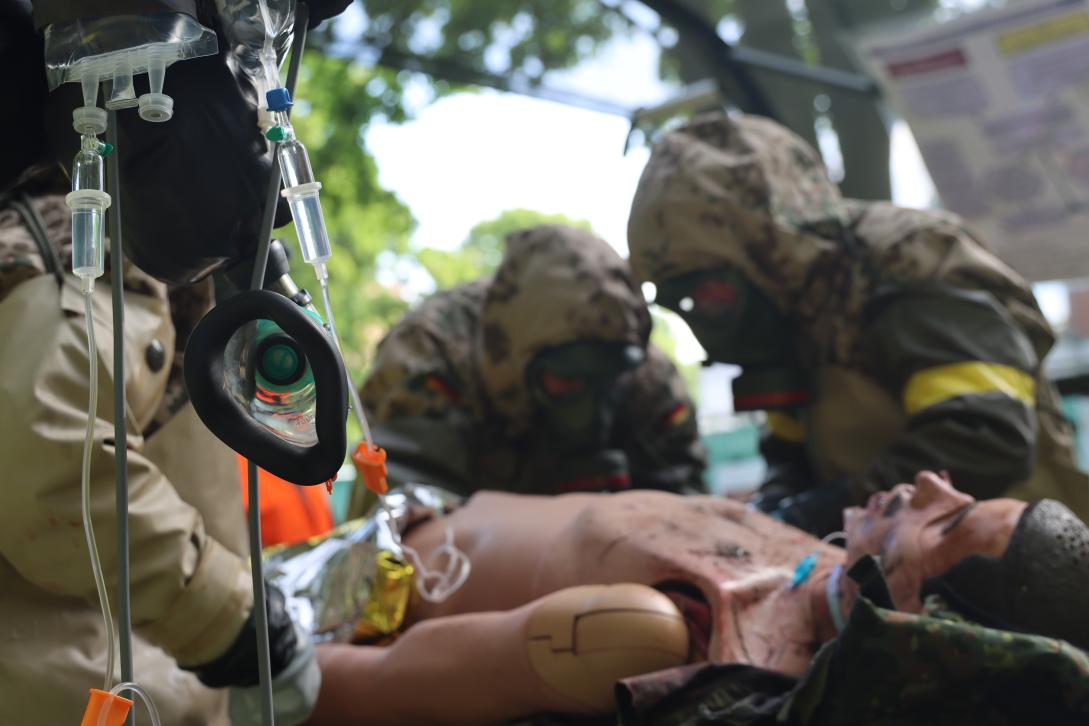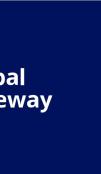Medical CBRN Training for Ukrainian Medical Personnel in Southern Germany

This training is part of the European support mission EUMAM UA. The objective is to prepare medical personnel for casualty care under CBRN conditions. The training is conducted under German responsibility at a secure site in southern Germany. Target groups include physicians, emergency paramedics, and nursing staff. The training follows a modular structure. The main focus is on putting on and taking off donning and doffing protective equipment, decontamination, emergency medical first aid under CBRN protection, triage and situation assessment and detection procedures. Medical interventions must be performed under time pressure. The on-site medical decontamination facility is designed for the parallel treatment of two severely injured patients.
“We are a heterogeneous team specialized in medical CBRN protection. The training involves specially trained medical professionals such as emergency doctors and paramedics, as well as soldiers from the CBRN defense forces with extensive expertise in decontamination. Our team is well-coordinated through years of collaboration, and we are very pleased to pass on our knowledge to our Ukrainian comrades. Each successfully completed scenario by the trainees gives us another motivational boost for our work,” explains Lieutenant Colonel (Medical) Lars K., who leads the training.
The medical care provided under protective conditions follows an algorithm-based trauma protocol using the MARCH scheme. This structured approach originates from tactical medicine and ensures life-saving procedures are carried out in the correct order under severe time constraints. The five elements of the MARCH protocol are:
Massive bleeding – controlling severe hemorrhages
Airway – securing and maintaining open airways
Respiration – supporting breathing and treating thoracic injuries
Circulation – stabilizing circulation and combating shock
Head Injury/Hypothermia – treating head injuries and preventing hypothermia
This standardized method enables medical personnel to act quickly and effectively in contaminated environments. The MARCH protocol is supplemented by early administration of the appropriate antidotes (counteragents for chemical warfare agents). The focus lies on interventions that must be performed in a contaminated setting without spreading the contamination. Additionally, procedures for identifying chemical and radiological agents are taught, including mobile sensor technology and detection methods. The training covers typical chemical warfare agents such as nerve agents (e.g., VX or Sarin), which are lethal even in minute doses, and pulmonary agents like chlorine gas or CS gas (tear gas), which cause respiratory distress, coughing, and mucous membrane irritation.
Situation Assessment and Detection Procedures
A central component of CBRN training is the so-called detection procedure, a systematic process for identifying, locating, and assessing chemical, biological, radiological, and nuclear threats in operational areas. For medical personnel, this process is essential to identify potentially contaminated zones and to provide targeted medical treatment under protective conditions. During training, participants learn to use detection devices and rapid test kits. This is complemented by visual and sensory observations and structured documentation of the situation. These records form the basis for subsequent steps such as decontamination, triage, and targeted resource deployment. Special emphasis is placed on tactical feasibility. Procedures are practiced under time constraints, in full protective gear, and in realistic scenarios. The goal is to obtain accurate measurements even under stress and to derive appropriate medical and tactical measures—without compromising the protective effect of the equipment.
Tactical and Medical Applicability
The training is conducted in a controlled setting but closely reflects operational realities. Only Ukrainian soldiers are being trained, who will return to their homeland upon completion. Whether they will be deployed directly at the front or in rear medical structures remains open. Exercises are carried out under time pressure and physical strain. Scenarios include casualty care in contaminated environments, triage under CBRN conditions, and transfer to follow-up rescue units or treatment facilities. The focus is not only on tactical proficiency but also on performing regular life-saving medical procedures while maintaining protective measures for the medical personnel.
Sergeant Major Lisa S., a trainer, shares: “As a nurse and training NCO, my task in the Medical CBRN training is to combine emergency medical treatment with decontamination measures. This regularly pushes our trainees to their limits, as working accurately in CBRN protective gear is demanding—especially under the early summer weather conditions. The participants are highly interested in our procedures, and we also benefit from the Ukrainian soldiers’ experience in treating wounded comrades. This makes the training highly valuable for everyone involved.”
Julija, an experienced medic who has been deployed to the front several times, states:
“I am very grateful for the professional support from the German soldiers. In Ukraine, we currently have no possibility of receiving such comprehensive CBRN training. A few months ago, several of my comrades were injured in an operation by tear gas used by the Russians. Since then, I’ve realized how important this knowledge is. That’s why I want to learn as much as possible here in Germany to better help my comrades when I return.”
Background and Purpose
Germany has its own experience in the CBRN field. The procedures are based on Bundeswehr standards and are continuously adapted to new operational realities. In Ukraine, there is a concrete threat from chemical weapons, industrial releases, and environmental destruction in combat. This includes agents like CS gas, which primarily attacks the respiratory system and can be used anywhere. The training is designed to prepare personnel for these situations and ensure adequate medical care under difficult conditions.
The Bundeswehr provides personnel, equipment, protective gear, and training facilities for this program. The Medical CBRN Training is part of Germany’s support efforts within the framework of EUMAM UA





